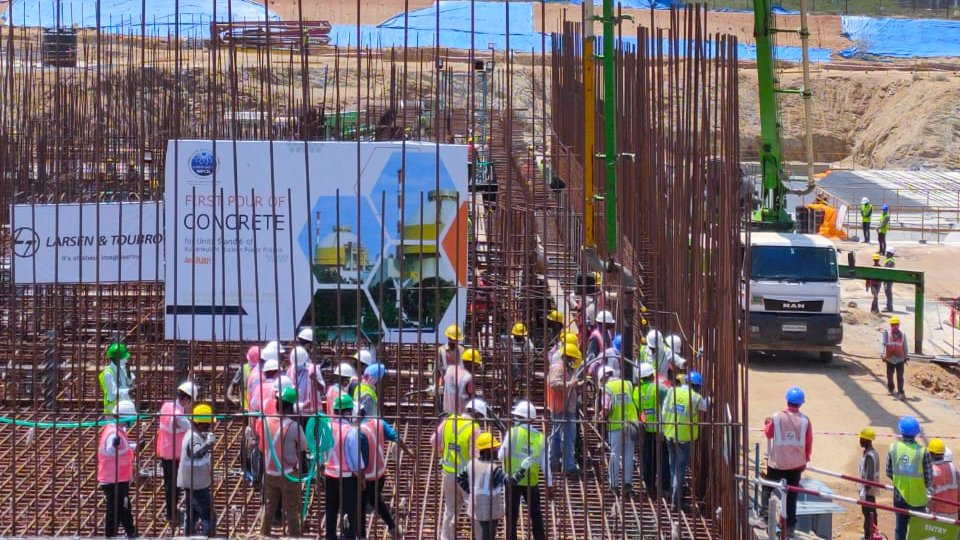In a significant moment for the nuclear energy cooperation between India and Russia, the first concrete pouring into the foundation plate of the fifth reactor unit for Kudankulam Nuclear Power Plant was held in Tamil Nadu today, commemorating the official commencement of the main stage of the nuclear power plant stage 3 construction.
The first concrete pouring was preceded by continuous preliminary work: concrete bedding for foundations of the reactor building, auxiliary reactor building with the main control room, turbine building and power supply building for normal operation, emergency power supply and safety control systems.
Civil nuclear cooperation between India and Russia remains an important component of strategic partnership.
"It demonstrates our firm devotion to achieve success in all bilateral undertakings," tweeted Nikolay Kudashev, the Russian Ambassador to India.
Today, construction of Kudankulam NPP Unit 5 began in India. The plant is being constructed to Rosatom design and will have 6 VVER-1000 PWRs. These are our southernmost power units to date. Here is to much more nuclear power for our friends in India (KKNPP press office photos) pic.twitter.com/YpZ2FLnwOa
— Rosatom Global (@RosatomGlobal) June 29, 2021
The Russian State Atomic Energy Corporation Rosatom, which has one of the largest foreign project portfolios in the world with 35 power units at different stages of implementation in 12 countries, said country's enterprises are already manufacturing equipment required for the first priority installation, the equipment for the reactor facilities and turbine hall for Unit 5.
"For many years the Kudankulam NPP construction project has been a symbol of close cooperation between Russia and India. However, we do not want to stop at what had already been achieved. Rosatom has all the most advanced nuclear power technologies," Rosatom Director General Alexey Likhachev stated during the ceremony on Tuesday.
"Together with our Indian colleagues we are ready to launch the serial construction of the state-of-the-art Generation III+ Russian-designed nuclear power units at a new site in India. It is stipulated by the existing agreements," he revealed.
The Kudankulam site presently has two reactors – KKNPP 1&2 (2X1000 MW) in operation and two reactors, KKNPP 3 & 4 (2X1000 MW) under construction. With the construction work for two more units – KKNPP 5 & 6 (2X1000 MW) having commenced, on progressive completion of units 3 to 6, the Kudankulam site will have a total capacity of 6000 MW and will be referred to as a Nuclear Power Park.
The total completion cost of the six units at Kudankulam, expected to be completed progressively by 2025-26, is Rs 111932 crore.
Nuclear power generation key to the future
Nuclear energy is a clean, environment-friendly base load source of power available 24X7 and also has huge potential which can ensure long term energy security of the country in a sustainable manner.
Presently, the nuclear power plants contribute about 3% of the total electricity generated in the country with two public sector companies of the Department of Atomic Energy, Nuclear Power Corporation of India Limited (NPCIL) and Bharatiya Nabhikiya Vidyut Nigam Limited (BHAVINI) involved in nuclear power generation.
The Narendra Modi government had in 2017 accorded administrative approval and financial sanction for construction of 12 nuclear power reactors – 10 indigenous 700 MW Pressurized Heavy Water Reactors (PHWRs) to be set up in fleet mode and two units of Light Water Reactors (LWRs) to be set up in cooperation with Russian Federation to enhance nuclear power capacity in the country.
There are presently 22 reactors with a total capacity of 6780 MW in operation and one reactor, KAPP-3 (700 MW) has been connected to the grid on January 10, 2021. In addition, there are 8 reactors totaling to 6000 MW under construction at various stages.

A core catcher being installed at VVER-1000-based Kudankulam Unit 4 in India. This unique Rosatom invention is designed to catch molten core of a reactor in the unlikely event of a meltdown, preventing it from escaping the containment building (Image courtesy: Twitter/@RosatomGlobal)
On progressive completion of the projects under construction and accorded sanction, the nuclear capacity is expected to reach 22480 MW by 2031. The Government has also accorded 'in-principle' approval for five new sites for locating nuclear power plants in future.
Minister of Atomic Energy and Space, Jitendra Singh, had told Lok Sabha last year that there is no proposal under consideration at present to permit non-government sectors in the area of nuclear power generation.
"However, the private sector participates in the nuclear power sector by providing core reactor components, equipment, materials and services in areas that include construction, fabrication and erection of equipment, piping, electrical, instrumentation, consultancy, auxiliary and logistical services," Singh had informed.
ALSO READ:
India-Russia defence ties grow closer as desperate Pakistan tries cosying up to Moscow
After Jaishankar’s UN address, Doval engages Russia’s Patrushev on Afghanistan in Dushanbe




















